Dec 15, 2025
Dec 15, 2025
by Rajika Puri
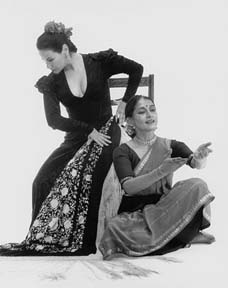 The idea of 'Flamenco Natyam' started very simply. During a trip to New York in 1997, my friend and flamenco dance teacher, La Conja, asked me if I would choreograph Indian movements to a piece of music written by her musical director, the composer-guitarist Pedro Cortes, Jr. - PANI, a duet for sitar and flamenco guitar. She suggested that the first part of the musical suite, an alegrias, could be done as a solo by me, and the second, a solea por bulerias would be a duet between Conja and myself. Her intention was to feature this collaboration during her annual New York concert.
The idea of 'Flamenco Natyam' started very simply. During a trip to New York in 1997, my friend and flamenco dance teacher, La Conja, asked me if I would choreograph Indian movements to a piece of music written by her musical director, the composer-guitarist Pedro Cortes, Jr. - PANI, a duet for sitar and flamenco guitar. She suggested that the first part of the musical suite, an alegrias, could be done as a solo by me, and the second, a solea por bulerias would be a duet between Conja and myself. Her intention was to feature this collaboration during her annual New York concert.
Little did we know that the success of this venture would lead to an invitation, by the prestigious Works & Process series of the Guggenheim Museum in New York, to present an evening on the connection between Flamenco and Indian dance, with reference also to the Indian origins of the gypsies of southern Spain. Three sold-out nights, which we called FLAMENCO INDIA!, then led to a tour of India, where we added a complement of Indian musicians, choreographed two more pieces, and changed the name of our show (which in Delhi was co-presented by the ICCR and the Spanish Embassy) to FLAMENCO NATYAM.
As the idea grew, so did the choreography develop, from something with an Indian flavor presented during a regular flamenco concert accompanied by western musicians, to a more balanced blend of music and dance from south India and southern Spain.
From Hindustani to Carnatic
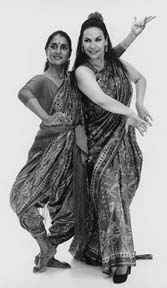 Written in homage to his Indian ancestry, Pani (which means 'water' in Calo, the language of the Spanish Gypsies, as well as in Hindi) includes many tabla rhythms. So for my initial movement patterns I turned to Odissi, thinking that there would be more similarity between the tabla patterns and those of the pakhawaj which accompanies Odissi. The footwork of Odissi, too, is more conducive to the rippling rhythms of north-Indian music - tin tarikita taka, tak tarikita taka, or tak taathin taka dhaatin - and the continual flow of hand movements with encircling of wrists is similar to the brazeo arm and hand movements of classical flamenco.
Written in homage to his Indian ancestry, Pani (which means 'water' in Calo, the language of the Spanish Gypsies, as well as in Hindi) includes many tabla rhythms. So for my initial movement patterns I turned to Odissi, thinking that there would be more similarity between the tabla patterns and those of the pakhawaj which accompanies Odissi. The footwork of Odissi, too, is more conducive to the rippling rhythms of north-Indian music - tin tarikita taka, tak tarikita taka, or tak taathin taka dhaatin - and the continual flow of hand movements with encircling of wrists is similar to the brazeo arm and hand movements of classical flamenco.
The minute we got into a studio with the musicians, things began to change rapidly. The gentle flow of music I had heard on the tape of a radio broadcast of Pani, now began to gather the wonderful tension and attack of modern flamenco music and dance. Rhythmic combinations would end with a sharp freeze, followed by silence for a couple of beats, only to soon resume their urgency. Next thing I knew, my body began to execute the strong sharp lines of Bharatanatyamadavus. My feet began to stamp with the force of the south Indian dance form, as I learnt to end, not on our sam (which would be their beat 12) but on beat 10 Taam _ ta kita, tei _dhi nata, taka dhiku, kitataka tarikita, tom ?!
Then Pedro asked me to sing something to the melody being played by his guitar. At first I looked for a Hindi poem, a ghazal or something similar, thinking still in terms of north India, and the Hindi word 'pani'. But then he asked me to beat foot rhythms while I sang (thought I can hold a tune, I am NOT an inspired singer!). So the most natural outcome was a tillana-like sequence to complement the teermanam I had devised for that fragment of melody: "tanana dheem dheem dheem, tana dhirana . . ."
Conja had asked me to include some abhinaya, even though the song had no wordsper se. Again, I first turned to gentle undulating movements which would suggest water, clouds, drops of rain, drawing from the Odissi hand-gesture vocabulary. But as the music became more compelling, I began to get images of Shiva as Gangadhar, of torrents of water falling into his jata, of thunder and lightning. Thehasta became more defined, as fingers started to stretch, and the body took on the symmetry and angularity of Chola sculpture, as opposed to the typical bhnagis of the Oriya art form.
The Duet
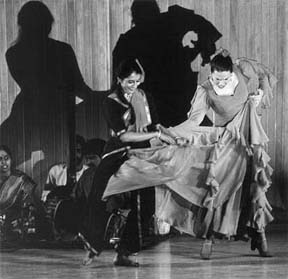 After an interlude, during which Conja first had me 'rap' with sollu (syllables of Bharatanatyam rhythm), then did a duet between her feet and the tabla, after which both of us did non-rhythmic movements tositar and guitar solos respectively, we came to the highlight of Pani - the duet between Conja and myself.
After an interlude, during which Conja first had me 'rap' with sollu (syllables of Bharatanatyam rhythm), then did a duet between her feet and the tabla, after which both of us did non-rhythmic movements tositar and guitar solos respectively, we came to the highlight of Pani - the duet between Conja and myself.
The duet had come alive in the studio over several weeks. As a way to start, Conja would choreographed her own movements to the complex rhythms, inspired by Indiantihais, which Pedro had written. I would then 'translate' her flamenco movements into sequences using elements from Bharatanatyam adavus. As we worked we explored designs made by our two bodies in space, not excluding the obvious images of a single body with multiple arms, or Conja raising her legs in a Nataraja-like pose, as suggested by Indian sculpture. Soon, however, we moved on from such clichés. We began to play off each other's traditions, covering larger areas of space and creating tensions between our bodies as well as melting body images together.
Conja would clap out a rhythm, I would respond with an adavu (Bharatanatyam step) where the foot patterns complemented her sounds; I would lunge into a fullmandi ('sitting') position, Conja would do a spiral turn; her lightning-fast feet articulated the rhythm of a guitar falseta (melodic variation), I performed ateermanam. Then, instead of the typical sawal-jawab ('question- answer') format, we started to dance simultaneously. We circled each other like tigresses from different continents, stood back to back as the lights threw shadows on the scrim, and occasionally even danced in unison. In her ruffled skirts she was a wildflamenca, full of passion and a yang energy, while I, dressed in a black and flame red Bharatanatyam trouser-like costume, looked relatively yin and shanta (tranquil).
At the end, however, in typical Flamenco fashion, we built up the rhythm, ending in a fast-paced and brilliant teermanam which I spoke while she did her extraordinary footwork, ending together in a flourish from our respective traditions.
A Learning Process
What we both learnt from the initial phase - her 1997 New York concert, the Guggenheim show, and the India tour - was the importance of knowing each other's traditions. Conja had studied Kathak as a child, and is a great aficionado of Indian music. She has Arab roots and instinctively understands the flavors of eastern poetry. My own connection with Flamenco goes back thirty-five years, since when not only do I speak Spanish but can (sort of) sing the odd Flamenco song, and perform simple alegrias, bulerias, and solea dances. As we continue to explore new strategies for working together, we learn more about each other's music and dance traditions. Both Flamenco dance and Bharatanatyam are closely allied to their musical traditions. Indeed, they are a PART of their respective musical traditions. La Conja is a wonderful singer, often invited as guest artist to perform with great dance companies such as those of Jose Greco. Ideally, and with good musicians, both Bharatanatyam and Flamenco dance are improvised as is the music that they dance to. Of course there are cues?ways of marking rhythms so that musician and dancer can communicate a change. In both traditions, dancer and musicians must listen to each other and TOGETHER make great music.
True, we both use footwork, arm and hand movements, and are concerned with expressing basic moods - bhava, aire - leading to rasa or an expression of duende. In contrast to northern European music, both forms of music use quarter-tones, and complex rhythms. But it is from the differences that one learns most of all. As we came back to regular flamenco and Bharatanatyam, respectively, we understood better the particularities of our own traditions. I feel I am a stronger Bharatanatyam dancer now. I think Conja has grown as a flamenco performer.
'Fusion', and the dynamics of cultural change
I suppose what we attempted could be classed under the general rubric of 'fusion', though I prefer to think of it as part of a natural process of cultural borrowing that takes place not only in music and dance, but also in language, in customs, and ways of life. Our present age, with its many possibilities for instant global communication has been reflected in the profusion of cultural meetings in all aspects of the arts, the performing arts, - in particular. As a result traditions themselves are fast changing - Flamenco being a perfect example of this. In the last thirty years, Flamenco music has incorporated Afro-Caribbean rhythms, north-African melodies, jazz, and pop-music to the extent that the Peruvian cajon, tabla, ghatam, and sitar, and the Egyptian oudh ('lute') are commonplace in flamenco shows. Young Spanish audiences and young flamencos alike, want to experiment. They are often impatient with the 'classics', especially old-fashioned singers and dancers whose work is not of the top quality. In India, too, young people turn away from classical arts to the point that great performers like Zakir Hussein and Hari Prasad Chaurasia themselves turn to other countries for inspiration, and in response of the needs of their younger audiences. They have between them explored the music of Brazil, Japan, China, and Spain, not to mention jazz and afro-rhythms as well. "Fusion' music is most prevalent in films, and in the pop culture - on cat-walks, in discos, and blaring away at street corners everywhere.
Cross-cultural blends in dance
Indian dance forms like Bharatanatyam, too, look for ways of making contemporarily appropriate meanings that 'speak' to the current generation of 20-30 year olds - performers and audiences alike. Moving away from one's carefully learnt craft for a while gives one an opportunity to see it afresh, and without the blinkers necessitated in being a 'good pupil'. As Conja and I work out new pieces, often presenting them to young audiences at universities, we find an instant rapport not always present when we dance our traditional repertoires. Conja has always played with the music and dance of other countries - she has sung Flamenco songs in Arabic. Her
concerts now include dances set to music by Nusrat Fateh Ali Khan, and she continues to look for other kinds of Indian music.
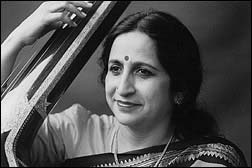 For myself, I am returning to Bharatanatyam by re-thinking its relationship to its music, and also its very aesthetics - its use of space, its visual impact, its costume. On the one hand I am working with a wonderful Carnatic singer, Aruna Sairam, figuring out strategies for movement during her regular vocal recitals, attempting to follow her improvisations without interfering with her sublime music. We have performed a set of concerts entitled "South Indian Classical music and its dance" in Spain and in Maheshwar, Madhya Pradesh. Aruna keeps teaching me that 'less is more" - less movement, less costumes, less sound, less overt abhinaya.
For myself, I am returning to Bharatanatyam by re-thinking its relationship to its music, and also its very aesthetics - its use of space, its visual impact, its costume. On the one hand I am working with a wonderful Carnatic singer, Aruna Sairam, figuring out strategies for movement during her regular vocal recitals, attempting to follow her improvisations without interfering with her sublime music. We have performed a set of concerts entitled "South Indian Classical music and its dance" in Spain and in Maheshwar, Madhya Pradesh. Aruna keeps teaching me that 'less is more" - less movement, less costumes, less sound, less overt abhinaya.
On another front I am working in partnership with Preeti Vasudevan, brilliant student of the Dhananjayans, to develop pieces that use Bharatanatyam technique andabhinaya in ways that give a contemporary voice to this traditional form. Our first concert held in New York in November 2000 and entitled "Bharatanatyam Variations" was essentially to a modern dance audience. Initial feed back from modern dance presentors was that they were pleased to see that while our work expressed a post-modern aesthetic and was exciting, it clearly adhered to our traditional form.
Looking Ahead
Given the rush of creativity that began by Conja's invitation to me to choreographPani, I thus maintain my concerts with her, too, since they continue to be a source of inspiration. I get a double fulfillment: I sometimes get to dance to Flamenco music, which I adore, and then come back to my first love, Bharatanatyam performed to Carnatic music, refreshed, and energized. My goal now is to bring more and more people into the fold of Indian dance, by expanding the vision of its possibilities - as a dance form, a musical form, a theatrical form, and as a language of the vital soul of a peoples. Bharatanatyam is much more than it has been, or that we think it should be - it has a quality of infinitude encapsulated by its greatest practitioner - Lord Shiva, himself.
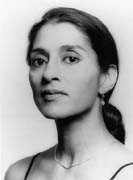 Trained in Bharata Natyam by Sikkil Ramaswamy Pillai, among others, and Odissi of the Deba Prasad Das gurukul, Rajika Puri also has an MA in the 'Anthropology of Human Movement' from New York University. Apart from performing dance, she lectures and writes on Indian dance, theatre, and culture, and is active in the western theatre (she made her debut in Julie Taymor's production of The Transposed Heads at Lincoln Center, NY, and has played in films like Meera Nair's Mississippi Masala, and Deb Benegal's Split Wide Open).
Trained in Bharata Natyam by Sikkil Ramaswamy Pillai, among others, and Odissi of the Deba Prasad Das gurukul, Rajika Puri also has an MA in the 'Anthropology of Human Movement' from New York University. Apart from performing dance, she lectures and writes on Indian dance, theatre, and culture, and is active in the western theatre (she made her debut in Julie Taymor's production of The Transposed Heads at Lincoln Center, NY, and has played in films like Meera Nair's Mississippi Masala, and Deb Benegal's Split Wide Open).
Image Credits:
Tejbir Singh, Gilles Larrine and Rajika Puri
12-Mar-2001
More by : Rajika Puri

|
You have a very unique and fantastic dance form.want to cast you in the web auditions in this season's India's Got Talent in Colors tv. |